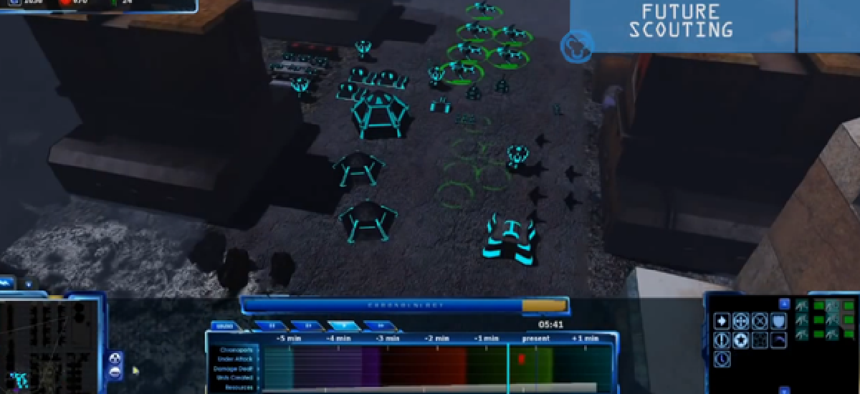Serious games scoring big in government


Connecting state and local government leaders
The growth of big data, analytics and the challenge of getting data consumers to use new tools is driving proliferation of serious games in government.
A few years ago, New York City officials turned the challenge of managing handicap accessibility into a game, giving points to people who submitted photographs of, for example, curbs that were too high for people in wheelchairs to navigate.
“What they started to notice was that people were doing a much better job in seeking these [situations] out when they started to play with it,” said Lindsay Grace, a communication professor at American University.
That was despite the fact that the reward – more ‘points’ – didn’t have any monetary value. The pay-off came from people’s desire to win and test limits.
“We could give them some [form of] direct transfer and say, ‘Congratulations. You earned 100 points, here’s a $10 gift card,’” said Grace, who co-presented a session on government gaming March 15 at the South by Southwest conference.
“The problem with that is it’s a form of work. It’s a form of labor. But if the experience itself is extraordinarily satisfying, then it pays for itself,” he said. “That’s why people do the work of a marathon or a fun run. They aren’t necessarily saying, ‘OK, what’s my payout?’ The experience itself is quite enjoyable.”
Government’s use of games is nothing new, but technological changes have, well, changed the game.
Today’s growth spurt in big data and analytics, combined with the challenge of getting the producers and consumers of data to engage directly with new tools, is driving the proliferation of large-scale games such as the one New York played.
In government, games and gaming methods have been gaining steam for training, change management and employee culture improvement as well as externally to boost citizen engagement.
“You’re creating an entrée for people that is quite attractive,” Grace said. “So it’s not, ‘Hey, we just wrote some really good policy and all you have to do is read these 630 pages.’ It’s ‘Well, we have a game that’s going to get you pretty far in understanding. Why don’t you try this first?’”
“Games have been used for eons,” added Tony Demarinis, director of gaming at Deloitte Consulting, who cited lacrosse’s roots as a battle-training tactic. “There are intangible attributes that require people to put disparate pieces of data together in a unique and creative manner to solve problems that you cannot get in any other form or fashion but in activities that look like games.”
Human computation games hold the most promise for government, he said, adding that three years ago there were 16 examples of these worldwide, and now more than 80 exist.
They use true game mechanics the way puzzles do, but the work players do is called an isomorph, a translation of a real-world problem. “Players are playing a game to solve a problem, but you don’t really care what the problem is. You’re just playing the game,” Grace said.
For instance, a space invader game in which players have to figure out what doesn’t look right is a great way to train information technology workers on network intrusion detection.
“If I told you this is work or I told you this is a game, you change the way you frame the problem psychologically,” Grace said. “You’re more driven to experiment, you’re more driven to get the optimum solution.”
IBM is a company that sees the value of game formats for government applications and challenges. The firm’s Smartplay program helps to integrate real processes and data into problem-solving games for the military and other government agencies. Using its cloud infrastructure and applications to incorporate adaptive analytics, business process management, learning management systems and social business applications, IBM is developing a number of serious games, designed to solve business puzzles.
It has two main games: CityOne has been compared to the popular SimCity game, where players develop a city, while Innov8 lets players practice running a business.
IBM is also acting as a “second use marketplace where game developers can repurpose what was initially created for entertainment and resell it as practical solutions to complicated problems informed by real-world data,” according to a Motherboard article. That’s what happened to Achron, a real-time strategy game that was not a success with the public but was picked up by the Pentagon for use in logistics training.
"The premise here is that we know you've worked hard to create intellectual property," said Phaedra Boinodiris, Serious Games program manager at IBM, during a game developers conference earlier this month.
"Whether it's a game, an analytics engine, a gaming engine, whatever this intellectual property is that you might have, we see an opportunity to leverage this as part of a broader ecosystem to make games as a service happen for some of this clientele."
Another company, BreakAway Games, created Code Yellow, a game that lets hospitals enter their own data to simulate, test and improve their readiness for disaster response.
Overall, games are overcoming their stigma as amusement for the couch potato to gain wider audiences, acceptance and uses, Grace said.
“If you look at the history of Angry Birds – a very popular casual game – it basically calculates to 380 years of computation,” he said. “The amount of time that people are solving problems on Angry Birds is a tremendous amount of cognitive labor. So the idea is why don’t we convert that? If we can get even a couple of those hours for people to solve other problems, imagine the kinds of problems we can solve.”
NEXT STORY: DHS spurs wearable tech for first responders




